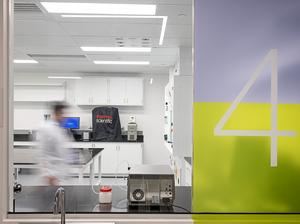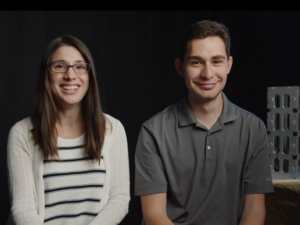One stroll around Freight Farms’ new Southie space, and I can’t help but think one thing: This is not normal.
Sure, I’ve seen a lot of startup offices, and all of them have their cool amenities and memorable quirks. But this is different. And not, like some companies, because there's a frisbee flying around or a pińa colada machine in the kitchen. Maybe it has something to do with the enormous green box in the middle of the room, which has been used for everything from a nap pod to a phone booth. Or the signature hydroponic farm installed on-site—meaning fresh produce for all employees/visitors. That’s certainly something I’ve never seen before.
But in talking to a couple staff members I realize it’s more a vibe, and one you can't quite put your finger on, at that. The people are here to work, of course, but it feels more like they’re here because they actually believe in something. And that would be the high-volume crop production units they're providing, which support farming in any climate.
As it turns out, co-founders Jon Friedman and Brad McNamara take a unique approach to hiring—which may explain a lot.
“Experience is great, but it’s all about scrappiness,” says Friedman. “That willingness to identify a problem and just fix it. A fast and loose mentality.”
Sometimes, candidates have come in with a particular position in mind and ended up landing another role entirely. Or, there have been occasions when there weren’t any openings, but the cofounders saw potential for a person at Freight Farms regardless, and brought them onto the team. As an example, Friedman cited one employee who had a pretty bare resume, but had just spent a couple weeks fishing in Alaska. They knew right away he would fit in perfectly.
Back at the beginning of the year—hot off the heels of a new $3.7 million funding round—Freight Farms had about 11 employees, and now they’re up to 18. Most of that hiring has been for more specialized roles like customer service, sales, and design. They would have been bursting at the seams in their old Seaport office, which was about 1,000 square feet, so they moved to their current 4,000-square-foot digs, right across from Murphy’s Law, in April.
Freidman and McNamara say they chose this particular office because it’s not only ultra tour friendly, but gives the feeling of a showroom experience as someone’s walking through—an advantage when customers or potential customers are paying a visit. Plus, they have the ability to do R&D right on site, which is key.
As for the culture, McNamara says meetups outside work are rarely, if ever, planned—but they just seem to happen anyway. Like their recent yoga takeover where an employee’s wife is a teacher (which apparently left a couple regulars miffed), or their team runs around Castle Island, or volunteering at a local food festival.
“Yeah, we really hate each other,” says marketing manager Caroline Katsiroubas, oozing with sarcasm.
Naturally, a visit to Freight Farms wouldn't be complete without a peek inside the farm, either—which, at 320 square feet, offers the equivalent of 1.8 acres of land. The team is prepping for an upcoming conference in Indianapolis about two weeks off, at which they'll show what their farms are capable of to food service groups. An increasing number of schools are demanding locally-sourced foods, says Katsiroubas, and that's where Freight Farms comes in.
Everything in the freight is controlled carefully, from the CO2 and humidity to nutrient and water levels. LED lights in different colors have varying wavelengths, catering to the unique needs of any particular plant. Tubes run down the center of the owners, blowing air up at the crops for optimal circulation. And irrigation lines run across the ceiling, filtering the water down, which is then fed back to a tank in the back. When they're ready, the grow plugs (seedlings) get spaced out into a long cubed strip made out of recycled BPA-free water bottles, then placed in the vertical towers to grow. In about three to four weeks, they'll be baby heads of lettuce, kale, arugula, basil, mint, mustard greens or Swiss chard.
While these are the crops most customers start with, McNamara noted that some will get creative once they're a little more knowledgeable and experienced with the system. That means growing anything from peppers to cucumbers or other vegetables. Lately, as they've been taking feedback from customers and observing them working in the freight farms, the company has been making small adjustments—like installing Bluetooth-enabled four-speaker systems so people can jam out while they're tending to their crops.
It's worth noting that the new digs marks a meaningful new phase in Freight Farms' development. McNamara tells me that in fact, this is the first independent office the company has had. In the past, the team has always worked out of mixed-use or shared spaces. It feels like the next chapter in a coming-of-age story. And this could very well be the spot where the startup truly thrives.
Video and photo of kitchen taken by Rebecca Strong. Other photos provided by Freight Farms.








